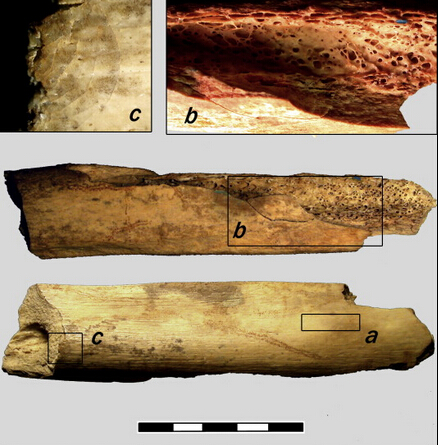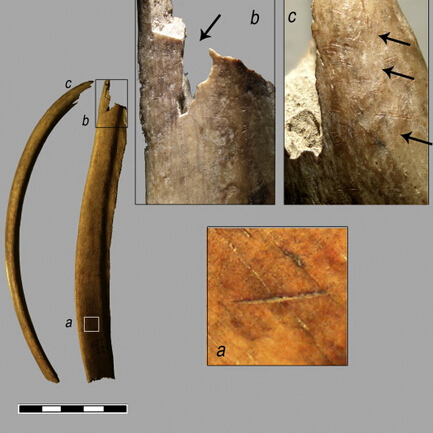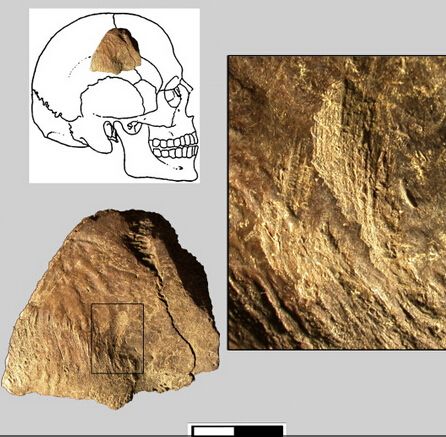There was an outbreak of cannibalism 10,000 years ago in Spain
From:Arstechnica NetWriter:Date:2017-03-24
The Mesolithic period in Europe, roughly 10,000 years ago, was a tumultuous time. Small groups of hunter-gatherers were undergoing a dramatic cultural transformation, making increasingly sophisticated stone tools with wooden components. They were on the cusp of the agricultural revolution, which would grant them a broader range of nutrition sources and greater food security. The environment was changing, too: the Ice Age was over, but the mid-Pleistocene warming period had not yet begun. And in a cave near the coast of Alicante, Spain, 120km south of Valencia, groups of humans began to engage in occasional acts of cannibalism.
This distal humerus shows distinct disarticulation cut marks where stone tools were used to separate this bone at the joint.
In a recent paper for Journal of Anthropological Archaeology, University of Valencia anthropologist Juan V. Morales-Pérez and colleagues describe their discovery of human bones covered in marks that suggest what they delicately refer to as "anthropophagic practices." Carbon dating suggests we're looking at meals from at least two different events between 10,000 and 9,000 years ago. Though 30 different human bones are buried in the cave, the researchers write that there are skull remains from only three individuals: a heavyset person, a more diminutive one, and an infant (the infant skull shows no sign of cannibalism). At a minimum, then, two people were eaten, and possibly several more. There are no signs of violence, so these people were probably eaten after death.
Identifying cannibalism is a tricky business, for both cultural and scientific reasons. First, we don't want to believe our ancestors ate each other, and second, distinguishing signs of cooking and eating from other kinds of damage that bones can suffer over thousands of years buried in a cave is difficult. Morales-Pérez and his team spent several years analyzing the bones, and they identified several telltale signs that point to cannibalism. They were guided in this investigation by previous work from a paper by Bruno Bulestin of the University of Bordeaux. He lays out this technical rubric:
(1) Direct proof: the presence of human bones within human coprolites or the identification of human bites on human bones.
(2) Indirect proof: mainly cooking or pot polish marks.
(3) First-order primary criteria: anthropogenic fracture and differential anatomical representation (if this anomalous representation is not related to post-depositional processes but to the functional exploitation of the bones).
(4) Second-order primary criteria: mainly cut marks.
(5) Secondary criteria that are not directly related to functional exploitation: position and preservation of the bones and presence of burned bones.
In sum, if you find human bones in fossilized human excrement (coprolites) or with human bites on them, you've probably got some cannibalism. Other evidence includes cuts on the bones from stone tools used for defleshing, disarticulating (pulling bones apart at the joints), skinning, and cracking open to get at marrow. And finally, evidence can come from the environment. If the bones are burned, or buried alongside animal remains with similar marks, those are additional clues that point to a feast that included human meat.

The researchers found evidence to fit all these criteria, minus the coprolites. The human bones were found buried in the back of the cave with other animal bones, all of which showed signs of butchery and burning. Humans had also gnawed on some of the bones, leaving clear signs of biting and tooth scraping behind. Though Morales-Pérez and colleagues admit that distinguishing human bites from other animal bites is sometimes difficult, they write in their paper that they found the most common sign of human chomping: "double arch punctures in crenulated edges or chewed ends, isolated triangular pits, or shallow linear marks associated with crescent pits." These marks also match those found on the remains of other animals in the cave, including ibex, deer, boar, fox, and rabbit.
Desperation or ritual?
Though this discovery offers us the first-ever example of cannibalism in Mesolithic Spain, the practice was not uncommon elsewhere in Europe and the Levant at this time. Cannibalism was also practiced during the Paleolithic, the "Stone Age" period that stretched from 2.5 million years ago to 11,700 years ago. The big question for anthropologists is why these Spanish cave-dwellers turned to cannibalism. Were they starving and desperate? Or was this part of a spiritual ritual, perhaps sparked by the cultural rupture between an extremely ancient way of life during the Paleolithic and a radically new one that emerged during the agricultural era?

More defleshing marks, this time on ribs.You can see an incision(a),notches(b), and scores(c).
We know from the wide variety of animal remains in the cave that these ancient people had a wealth of food sources, from both land and ocean. Yet there can be periods of scarcity, even in regions with temperate weather and many kinds of animals and plants. If there were many seasons of drought or an unlucky hunting season, these hunter-gatherers might have supplemented their already diverse diet with "occasional anthropophagy."
This would fit with the way the bones were treated. "They were slightly exposed to fire before they were fractured [and the] burns [could] be a constituent part of the butchering process," write the researchers in their paper. One body that was eaten was "processed in such a way that it was subjected to thermal treatment before it was fractured, perhaps with the intention of facilitating the extraction of the bone marrow." And of course, the bones were tossed in among other animal bones, like the remains of any other meal.

This is a frontoparletal fragment of a human cranium. It is covered with intense and flat chop marks, possibly from skinning and defleshing.
That said, we can't be sure these bones were treated with a cavalier attitude at the time of consumption. Thousands of years of rain could have washed the human bones into a waste pile at the back of the cave. If that's the case, we may be misreading the scene. These cannibalized individuals could have been given a ceremonial burial in a special place where humans lived at the cave entrance, but over time they wound up in a jumble with garbage bones from dinner.
Assuming these remains came from a ritual isn't farfetched. Ancient peoples occasionally had funeral practices that involved eating honored people as well as despised enemies. As the researchers note, "ritual complexity was clearly increasing with respect to previous ages at the time." Not only that, but new kinds of mortuary practices are specifically associated with the transformations brought about by Mesolithic life, when people lived in camps for longer periods of time and developed more sophisticated toolkits, art, and cooking techniques. Quite simply, "cannibalism and socio-cultural transformation phases are associated with each other," write Morales-Pérez and his colleagues.
If we shed our modern preconceptions, it's easy to imagine that people trying out new rituals and spiritual beliefs might occasionally experiment with cannibalism. When funerals were a novel idea and gathering food was central to all our activities, combining eating with a powerful, important ceremony would make sense. After all, food was possibly the most important thing in human life at the time.
Obviously, we can't be sure what really happened in that Spanish cave all those millennia ago. But the explanation may be far less disturbing than we might first imagine. We could be seeing what remains of our earliest complex rituals for honoring the dead.

